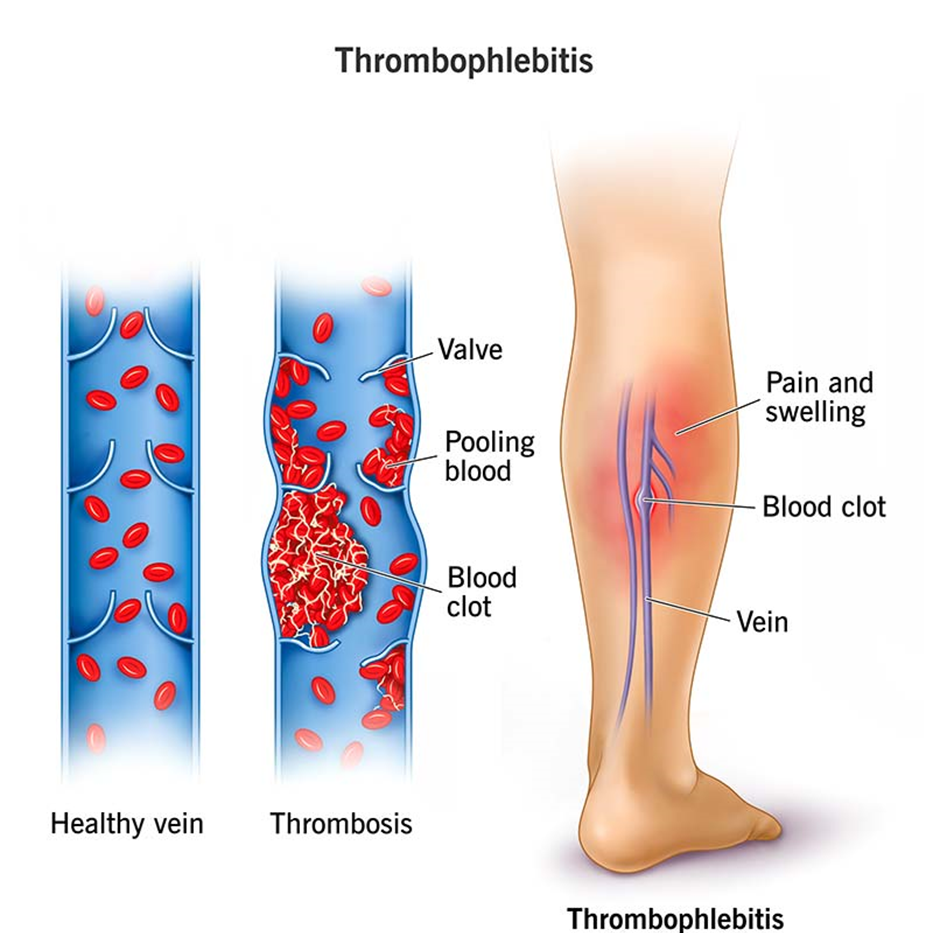A nurse is assessing a client’s peripheral IV during hourly rounding. The nurse notices the site has erythema, warmth, edema, and a red line traveling up the vessel. Which complication would the nurse identify this client has?
Thrombophlebitis
Infiltration
Infection
Extravasation
The Correct Answer is A
Choice A reason: Thrombophlebitis is characterized by inflammation of the vein with the formation of a blood clot. The signs and symptoms include erythema, warmth, edema, and a red line traveling up the vessel, which indicates the presence of inflammation and possible clot formation. This condition requires prompt intervention to prevent further complications such as the spread of infection or the clot traveling to other parts of the body.

Choice B reason: Infiltration occurs when IV fluid or medication leaks into the surrounding tissue. Signs of infiltration include swelling, discomfort, and coolness at the IV site, but it does not typically present with erythema, warmth, or a red line traveling up the vessel. Infiltration is less likely to cause the systemic signs seen in this case.
Choice C reason: Infection at the IV site can cause erythema, warmth, and edema, but it usually does not present with a red line traveling up the vessel. The red line is more indicative of thrombophlebitis, where the inflammation follows the path of the vein. Infection would also likely present with additional systemic signs such as fever.
Choice D reason: Extravasation involves the leakage of vesicant drugs into the surrounding tissue, causing severe local tissue damage. Signs include pain, burning, and blistering at the site, but it does not typically present with a red line traveling up the vessel. Extravasation is more localized and does not follow the vein’s path like thrombophlebitis.
Nursing Test Bank
Naxlex Comprehensive Predictor Exams
Related Questions
Correct Answer is A
Explanation
Choice A reason: Applying compression stockings is a key prophylactic intervention to prevent complications of immobility, such as deep vein thrombosis (DVT) and venous thromboembolism (VTE). Compression stockings help improve blood circulation in the legs by applying graduated pressure, which reduces the risk of blood clots forming in the deep veins. This is particularly important for immobile patients who are at higher risk of developing DVT due to prolonged periods of inactivity.
Choice B reason: Raising all side rails is primarily a safety measure to prevent falls and does not directly address the complications of immobility. While it is important for patient safety, it does not have a significant impact on preventing issues like DVT, pressure ulcers, or muscle atrophy. Therefore, it is not considered a prophylactic intervention for immobility-related complications.
Choice C reason: Inserting a urinary catheter is not a prophylactic intervention for preventing complications of immobility. Catheters are used to manage urinary retention or incontinence but can increase the risk of urinary tract infections (UTIs) if not managed properly. They do not address the primary complications associated with immobility, such as DVT or pressure ulcers.
Choice D reason: Using friction-reducing devices is important for preventing pressure ulcers and skin injuries in immobile patients. These devices help minimize friction and shear forces on the skin, which can lead to pressure ulcers. While this is a valuable intervention, it is not as comprehensive as compression stockings in preventing a range of immobility-related complications.
Correct Answer is C
Explanation
Choice A Reason:
The client has full range of motion in her wrist does not necessarily indicate a need to loosen the restraints. Full range of motion suggests that the restraints are not too tight and are allowing for some movement. However, it is important to regularly assess the client’s circulation, skin integrity, and comfort to ensure the restraints are not causing harm.
Choice B Reason:
The client is attempting to remove the restraint is a common behavior in clients who are restrained, especially if they are confused or agitated. While this behavior warrants close monitoring and possibly re-evaluating the need for restraints, it does not necessarily indicate that the restraints need to be loosened. The nurse should assess the client’s overall condition and consider alternative methods to ensure safety.
Choice C Reason:
The client has cyanotic digits is a critical finding that indicates impaired circulation. Cyanosis, or a bluish discoloration of the skin, occurs when there is a lack of oxygen in the blood. This can be a sign that the restraints are too tight and are restricting blood flow to the extremities. In this case, the nurse should immediately loosen the restraints to restore proper circulation and prevent further complications.
Choice D Reason:
The client denies discomfort is a positive finding, indicating that the client is not experiencing pain or distress from the restraints. However, the absence of discomfort does not rule out other potential issues such as impaired circulation or skin breakdown. Regular assessments are necessary to ensure the restraints are being used safely and effectively.
Whether you are a student looking to ace your exams or a practicing nurse seeking to enhance your expertise , our nursing education contents will empower you with the confidence and competence to make a difference in the lives of patients and become a respected leader in the healthcare field.
Visit Naxlex, invest in your future and unlock endless possibilities with our unparalleled nursing education contents today
Report Wrong Answer on the Current Question
Do you disagree with the answer? If yes, what is your expected answer? Explain.
Kindly be descriptive with the issue you are facing.
